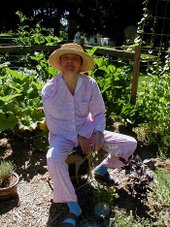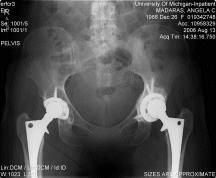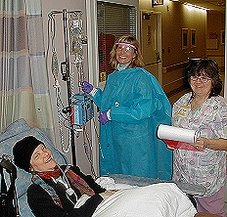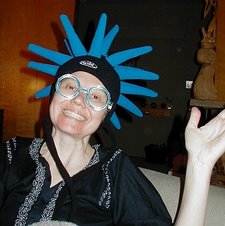What’s in your family tree? The latest thinking about lupus and genetics
by Jenny Thorn Palter
Bring the new baby home and you’re likely to hear, “He has his uncle’s ears,” or “That expression reminds me of her grandpa!” Later on, there may be other comments: “He has his father’s talent for music” or “Her grandmother loved to read, too.”
What you won’t hear anyone say is, “She’s going to have lupus, just like her mother.” That’s because there is still no way to predict exactly who will develop the disease and when -- or why.
Same Family ...
Christina Gomez, 21, and her younger sister, Adriana, 19, of Ontario, CA, know a little something about genetics. They both have lupus. In the Gomez family, the predisposition for autoimmune disease comes from both parents: Their father’s mother and one brother have severe rheumatoid arthritis, and their mother’s brother and a sister both have type 1 (juvenile) diabetes.
Adriana’s lupus diagnosis occurred in September 2003 when she was 13, after severe pain and swollen joints in her fingers caused the family to seek medical care. The first doctor said Adriana had rheumatoid arthritis and referred them to a pediatric rheumatologist. There was a two-week wait for an appointment, and Adriana says she spent the first week on the living-room couch. “My body hurt so badly I couldn’t move. The following week I saw the rheumatologist, who said it was probably something called lupus.”
... Different Symptoms
The pain also started suddenly for Christina -- in her legs and back, in 2007 when she was 19. “I couldn’t get out of bed. I couldn’t even turn my head, it hurt so much,” she remembers.
Within a week, the pain became so bad that she had to be carried into the emergency room. She couldn’t move at all. Her family suspected lupus all along, and after all the test results came back, she was diagnosed with lupus. That was nearly two years ago.
Even though Adriana had been told that lupus can occur in families, she was surprised that her sister developed lupus. Then when it happened, she expected Christina’s lupus would be pretty much like her own. “We’re sisters, we got diagnosed with the same condition, so you would think it would be the same. But after she had to make several visits to the ER in just a few months, it was obvious that her lupus was much more active.”
When asked how she felt when she learned of Christina’s lupus diagnosis, Adriana says simply, “I felt sad. It hurt to know that someone so close to you, someone you love, would have to go through the pain and suffering you’ve had to put up with.”
Why Lupus -- Why Me?
Humans inherit genetic material in the form of DNA (deoxyribonucleic acid) from their parents. Normally, this information is on 46 chromosomes arranged in pairs -- 23 chromosomes from each parent. A chromosome consists of a single, very long string of DNA called a helix that holds thousands of genes. Current science suggests human chromosomes carry 20,000 to 25,000 genes.
Genes are an important part of what determines physical appearance, behavior, and your susceptibility to diseases. An error or mutation in just one gene, or a change in the basic arrangement of chromosomes, can cause a serious medical condition. But most genetic disorders cannot occur unless both the mother and father pass along the responsible gene or chromosome. We do not yet know the exact causes of lupus, but it appears that genetic, environmental, and hormonal factors are all involved.
Studying twins has proven very helpful in examining the genetic and environmental influences that may cause disease. Identical twins possess the same genes, while non-identical twins, like any other siblings, share on average only half of their genes. Regardless of their genetic background, though, both identical and non-identical twins usually grow up in the same environment and share similar exposures during childhood. Therefore, comparing how frequently lupus affects identical versus non-identical twin pairs can provide valuable information about how the disease is influenced by genetic and environmental factors.
According to Frederick W. Miller, M.D., Ph.D., chief of the Environmental Autoimmunity Group, National Institute of Environmental Health Sciences at the National Institutes of Health, research shows that there is a 10 percent to 25 percent chance that an identical twin will develop lupus if the other one already has it. This drops to a two percent to five percent chance among non-identical twins. Compared with the approximately 0.08 percent frequency of lupus in the general population, this suggests that lupus has an important genetic component. Studies also suggest that the likelihood of developing other autoimmune diseases is higher in families in which a person has lupus.
Miller puts it this way: “There are multiple shared autoimmune disease genes that can get you into the theater of autoimmunity, and then there are other disease-specific genes, and probably certain environmental exposures, that escort you to your particular seat.”
There are few absolutely “good” or “bad” genes or environmental factors, Miller says. “Rather, the environment in which a gene operates defines how useful or harmful that gene will be, just as the genetic background of a person often determines the extent of the effects of environmental exposures.”
A Mother-Daughter Bond
Vivian Scott, 52, who lives in the
But the diagnosis led her to discover that she has a first cousin with lupus. “When I asked my doctor if diseases like lupus tend to occur in families, he told me that some families have a ‘propensity’ for them,” she says.
When Vivian was growing up, she remembers her mom would talk about how she and her twin sister were always considered ‘sickly,’ which was blamed on the fact that they were born prematurely -- a signature event for moms with lupus. “My grandmother would have been around 22 when she had my mother and aunt, and then she died at 26 of a brain tumor -- or so the story goes,” Vivian says.
It wasn’t until a few years ago that she considered this might all mean something else. “I visited a small farmhouse in
Vivian remembers being hospitalized in the third grade -- first, the doctors suspected leukemia, because the blood work was confusing. Then, they said it was rheumatic fever. Finally, they said they didn’t know what was wrong. She remembers fainting in grade school and junior high, which happened to her mother as well.
“My mom remembers me whimpering and crying a lot when I was little,” she adds, “and no one could figure out why. It also took years and years for me to get pregnant. My mom and sisters would joke about how fertile they were -- and then there was me.”
In spite of what she learned from her doctor about lupus running in families, Vivian says she never worried much about it while raising Vanessa, her only child. “I was horrified the day she came to me and said she didn’t feel well and both her arms ached. I just knew.”
Lessons Learned
When Vanessa was diagnosed with lupus in December 2002, she was a 17-year-old high school senior. Although she can’t recall a particular triggering event, she remembers being worried about taking the SATs and deciding where to go to college.
“In the summer of 2002, between my junior and senior year, my mom, one of her sisters, and I took a family road trip through
Vanessa was fortunate not to miss too much school during her final months in high school—but she had some inside help. “The nursing staff at school felt really bad for me, so they’d let me take little naps throughout the day,” she says. “Also, I told all my teachers, so if I was having an extremely off day, they’d let me go home early or come late. I just pushed through, and then I would go to bed as soon as I got home from school.”
This same determination now is helping her cope with the demands of her studies at Seattle University School of Law, where she is in the top 8 percent of her class. “I’ve wanted to be a lawyer since I was 10 years old,” she says. “I’ve always believed that if I can do this, I can be successful in anything.”
As for lupus possibly appearing in a fourth generation, Vanessa says she went through a phase of not wanting children, but now knows that she does. “I don’t know the odds of my children developing lupus if my mother and I have it, and I definitely would talk to my rheumatologist about that. It’s a hard thing to balance: deciding to not have a child in case it develops lupus, or deciding to have a child because if it did develop lupus, I would know what to expect and how to deal with it.”
The Possibility of Gene Therapies
So, while lupus is not hereditary in the traditional sense -- it is not the result of a single-gene mutation or a particular chromosomal error -- genetics researchers have uncovered information that may one day lead to innovative therapies.
One of the most exciting is the discovery that two gene mutations in the complement family -- C2 and C4 -- are linked to the development of lupus. The complement system is a group of proteins that work with the immune system and play a role in the development of inflammation. It is estimated that C2 deficiency occurs in one out of 10,000 people, nearly one-third of whom will develop lupus, and it is the most common single-gene deficiency seen in people with lupus.
Another area of study is the interferon pathway. Interferon is a protein produced in response to a viral infection. It acts to suppress viral growth. Increased interferon activity has been shown to be a heritable trait in families with a history of lupus.
Michelle Petri, M.D., M.P.H., director of the Hopkins Lupus Clinic at










